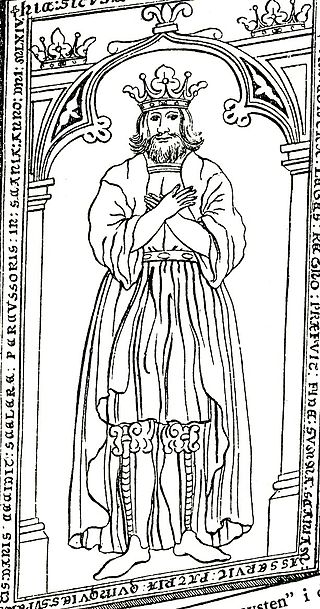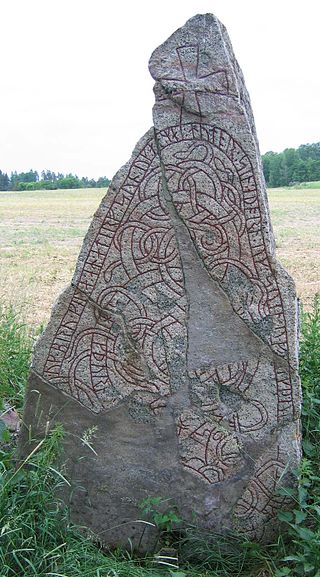Related Research Articles
Estrid of the Obotrites was Queen of Sweden in the Viking age, a West Slavic princess married to Olof Skötkonung, King of Sweden c. 1000–1022. She was the mother of King Anund Jacob of Sweden and the Kievan Rus' saint and grand princess Ingegerd Olofsdotter.

Swedish pre-history ends around 800 AD, when the Viking Age begins and written sources are available. The Viking Age lasted until the mid-11th century. Scandinavia was formally Christianized by 1100 AD. The period 1050 to 1350—when the Black Death struck Europe—is considered the Older Middle Ages. The Kalmar Union between the Scandinavian countries was established in 1397 and lasted until King Gustav Vasa ended it upon seizing power. The period 1350 to 1523 – when king Gustav Vasa, who led the unification of Sweden in the Swedish War of Liberation, was crowned – is considered the Younger Middle Ages. During these centuries, Sweden gradually consolidated as a single nation.

Olof Skötkonung, sometimes stylized as Olaf the Swede, was King of Sweden, son of Eric the Victorious and, according to Icelandic sources, Sigrid the Haughty. He succeeded his father in c. 995. He stands at the threshold of recorded history, since he is the first Swedish ruler about whom there is substantial knowledge. He is regarded as the first king known to have ruled both the Swedes and the Geats. In Sweden, the reign of king Olov Skötkonung is considered to be the transition from the Viking age to the Middle Ages, he was the first Christian king of the Swedes, who central Sweden. Norse beliefs persisted in parts of Sweden until the 12–13th century.
Richeza of Poland, a member of the House of Piast, was twice Queen of Sweden and once Princess of Minsk through her three marriages.

Håkan the Red was a king of Sweden, reigning for about half a decade in the second half of the 11th century. There is little information on him, and it is mostly contradictory. Nothing is known about his reign.

Inge the Elder was a king of Sweden. In English literature he has also been called Ingold. While scant sources do not allow a full picture of his term of kingship, he is known to have led a turbulent but at length successful reign of more than two decades. He stands out as a devout Christian who founded the first abbey in Sweden and acted harshly against pagan practices. The kingdom was still an unstable realm based on alliances of noblemen, and Inge's main power base was in Västergötland and Östergötland; one of the earliest chronicles that mention his reign knows him as rex gautorum, king of the Geats.

Blot-Sweyn was a Swedish king c. 1080, of disputed historicity, who was said to have replaced his Christian brother-in-law Inge as King of Sweden, when Inge had refused to administer the blóts at the Temple at Uppsala. There is no mention of Sweyn in the regnal list of the Westrogothic law, which suggests that his rule did not reach Västergötland. According to Swedish historian Adolf Schück he was probably the same person as Håkan the Red and was called the Blót Swain as an epithet rather than a personal name.
Erik Årsäll was a semi-historical king of Sweden. His historicity has been called into question. He is dated by some to the end of the 11th century, by others to the 1120s, while more critical historians believe that he is a legendary name belonging to the 10th century. According to some, he was the son of the pagan Swedish king Blót-Sweyn, and, like his father before him, administered the blóts at the temple at Uppsala. However, Erik does not appear in any Swedish or Danish primary sources.

Christina of Holstein-Gottorp was Queen of Sweden as the second wife of King Charles IX. She served as regent in 1605, during the absence of her spouse, and in 1611, during the minority of her son, King Gustav II Adolph.

Saint Eskil was an Anglo-Saxon monk particularly venerated during the end of the 11th century in the province of Södermanland, Sweden. He was the founder of the first diocese of the lands surrounding Lake Mälaren, today the Diocese of Strängnäs. He is the patron saint of Södermanland and the Diocese of Strängnäs.
Ingrid Ragnvaldsdotter was born a member of the Swedish royal family, became a member of Danish royalty by marriage and later was Queen consort of Norway as the spouse of Harald IV of Norway. Married four times, Ingrid had a number of children who played prominent roles in Swedish and Norwegian history.
Helena or Elin, possibly also known as Maer, Mär or Mö, was Queen of Sweden as the wife of King Inge the Elder, and a supposed sister of King Blot-Sweyn of Sweden.
Gunhilda of Wenden was a Polish princess, daughter of Mieszko I of Poland according to Chronicles of Thietmar of Merserburg, Adam von Bremen and Acta Cnutonis regis princess and Danish Viking Age queen consort, the supposed spouse of 10th-century King Sweyn I of Denmark. The sources about the wife or wives of Sweyn are contradictory, and historians have debated whether she is the Polish Świętosława given another name in Norse sources.
Estrid Svendsdatter of Denmark, was a Danish princess and titular queen, a Russian princess and, possibly, duchess of Normandy by marriage. She was the daughter of Sweyn Forkbeard and perhaps Gunhild of Wenden and half-sister of Cnut the Great. By Ulf Jarl, she was the mother of the later King Sweyn II Estridson and Beorn Estrithson. The dynasty that ruled Denmark in 1047–1412 was named after her. Though never a ruler or wife of a king, she was known in Denmark as queen during her son's reign.
Cecilia Johansdotter of Sweden is the possible name of the wife of King Canute I of Sweden and mother of King Eric X of Sweden. Little is known about her except that she was of aristocratic origins and died sometime after 1193.
Helen, is the assumed name of a medieval Swedish princess and Danish queen, Queen consort of King Canute V of Denmark. The date of her birth is not known; her father was King Sverker I of Sweden and her mother has been assumed to be Sverker's first spouse, Queen Ulvhild.

Boedil (Bodil) Thurgotsdatter was a Danish queen, queen consort of King Eric I of Denmark.
Ingerid Swendsdatter of Denmark was a Danish princess who became Queen of Norway as the spouse of King Olaf III of Norway.

Tyra of Denmark was a 10th-century Danish princess. She was the spouse of both King Olav I of Norway and of Styrbjörn Starke, prince of Sweden.
References
- Åke Ohlmarks: Alla Sveriges drottningar (All the queens of Sweden) 1976 (Swedish)